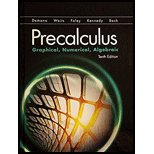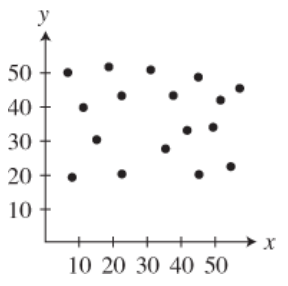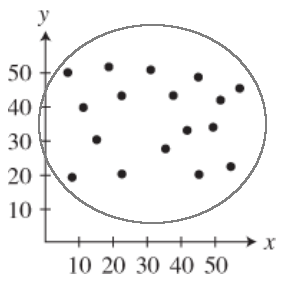
Concept explainers
To Describe:
The strength, and the direction of the
No Correlation.
Given:
The scatter plot of a data set:

Concepts Used:
When points on the scatter plot of a dataset are clustered along a straight line, then the data is said to have linear correlation.
The collective nearness of these points to a single straight line indicates the strength of linear correlation. This can be estimated by the width of an oval enclosing all the points tilted along the said straight line. The larger the width, the lesser is the strength of the linear correlation.
If the value of
Calculations:
Draw an oval enclosing the points on the data.

Interpretation:
The oval enclosing the points is almost equal in width and length. Thus, it is not tilted along any straight line, indicating no linear correlation.
Conclusion:
The given scatter plot represent a data set with no linear correlation.
Chapter 2 Solutions
EBK PRECALCULUS:GRAPHICAL,...-NASTA ED.
- 3. Determine the appropriate annihilator for the given F(x). a) F(x) = 5 cos 2x b) F(x)=9x2e3xarrow_forwardTangent planes Find an equation of the plane tangent to the following surfaces at the given points (two planes and two equations).arrow_forwardVectors u and v are shown on the graph.Part A: Write u and v in component form. Show your work. Part B: Find u + v. Show your work.Part C: Find 5u − 2v. Show your work.arrow_forward
- Vectors u = 6(cos 60°i + sin60°j), v = 4(cos 315°i + sin315°j), and w = −12(cos 330°i + sin330°j) are given. Use exact values when evaluating sine and cosine.Part A: Convert the vectors to component form and find −7(u • v). Show every step of your work.Part B: Convert the vectors to component form and use the dot product to determine if u and w are parallel, orthogonal, or neither. Justify your answer.arrow_forwardSuppose that one factory inputs its goods from two different plants, A and B, with different costs, 3 and 7 each respective. And suppose the price function in the market is decided as p(x, y) = 100 - x - y where x and y are the demand functions and 0 < x, y. Then as x = y= the factory can attain the maximum profit,arrow_forwardf(x) = = x - 3 x²-9 f(x) = {x + 1 x > 3 4 x < 3 -10 5 10 5 5. 10 5- 07. 10 -10 -5 0 10 5 -101 :: The function has a “step" or "jump" discontinuity at x = 3 where f(3) = 7. :: The function has a value of f (3), a limit as x approaches 3, but is not continuous at x = 3. :: The function has a limit as x approaches 3, but the function is not defined and is not continuous at x = 3. :: The function has a removable discontinuity at x=3 and an infinite discontinuity at x= -3.arrow_forward
- Calculus lll May I please have the solutions for the following examples? Thank youarrow_forwardCalculus lll May I please have the solutions for the following exercises that are blank? Thank youarrow_forwardThe graph of 2(x² + y²)² = 25 (x²-y²), shown in the figure, is a lemniscate of Bernoulli. Find the equation of the tangent line at the point (3,1). -10 Write the expression for the slope in terms of x and y. slope = 4x³ + 4xy2-25x 2 3 4x²y + 4y³ + 25y Write the equation for the line tangent to the point (3,1). LV Q +arrow_forward
- Find the equation of the tangent line at the given value of x on the curve. 2y3+xy-y= 250x4; x=1 y=arrow_forwardFind the equation of the tangent line at the given point on the curve. 3y² -√x=44, (16,4) y=] ...arrow_forwardFor a certain product, cost C and revenue R are given as follows, where x is the number of units sold in hundreds. Cost: C² = x² +92√x+56 Revenue: 898(x-6)² + 24R² = 16,224 dC a. Find the marginal cost at x = 6. dx The marginal cost is estimated to be $ ☐ . (Do not round until the final answer. Then round to the nearest hundredth as needed.)arrow_forward
 Calculus: Early TranscendentalsCalculusISBN:9781285741550Author:James StewartPublisher:Cengage Learning
Calculus: Early TranscendentalsCalculusISBN:9781285741550Author:James StewartPublisher:Cengage Learning Thomas' Calculus (14th Edition)CalculusISBN:9780134438986Author:Joel R. Hass, Christopher E. Heil, Maurice D. WeirPublisher:PEARSON
Thomas' Calculus (14th Edition)CalculusISBN:9780134438986Author:Joel R. Hass, Christopher E. Heil, Maurice D. WeirPublisher:PEARSON Calculus: Early Transcendentals (3rd Edition)CalculusISBN:9780134763644Author:William L. Briggs, Lyle Cochran, Bernard Gillett, Eric SchulzPublisher:PEARSON
Calculus: Early Transcendentals (3rd Edition)CalculusISBN:9780134763644Author:William L. Briggs, Lyle Cochran, Bernard Gillett, Eric SchulzPublisher:PEARSON Calculus: Early TranscendentalsCalculusISBN:9781319050740Author:Jon Rogawski, Colin Adams, Robert FranzosaPublisher:W. H. Freeman
Calculus: Early TranscendentalsCalculusISBN:9781319050740Author:Jon Rogawski, Colin Adams, Robert FranzosaPublisher:W. H. Freeman
 Calculus: Early Transcendental FunctionsCalculusISBN:9781337552516Author:Ron Larson, Bruce H. EdwardsPublisher:Cengage Learning
Calculus: Early Transcendental FunctionsCalculusISBN:9781337552516Author:Ron Larson, Bruce H. EdwardsPublisher:Cengage Learning





